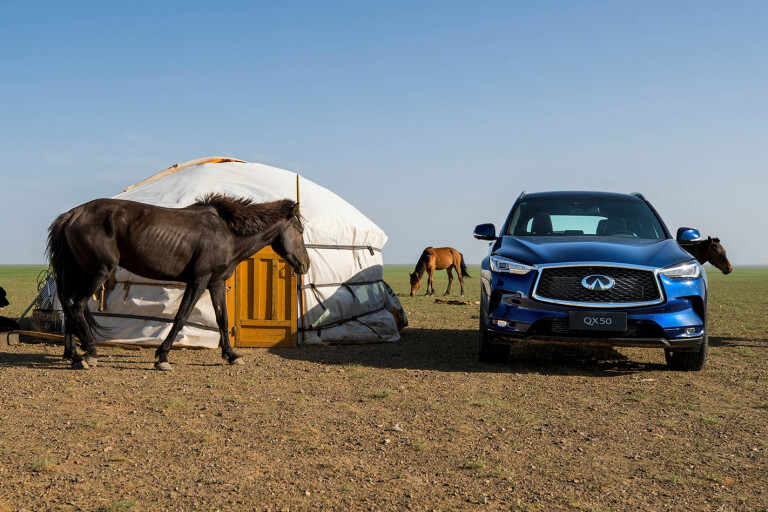
IF YOU wanted to design my personal Driving Hell it would look a lot like Mongolia. Not only is every second car you see on the road a Toyota Prius, every third one is too, and, while the country drives on the right (aka wrong) side of the road, something like half of its grey imports are right-hand drive.
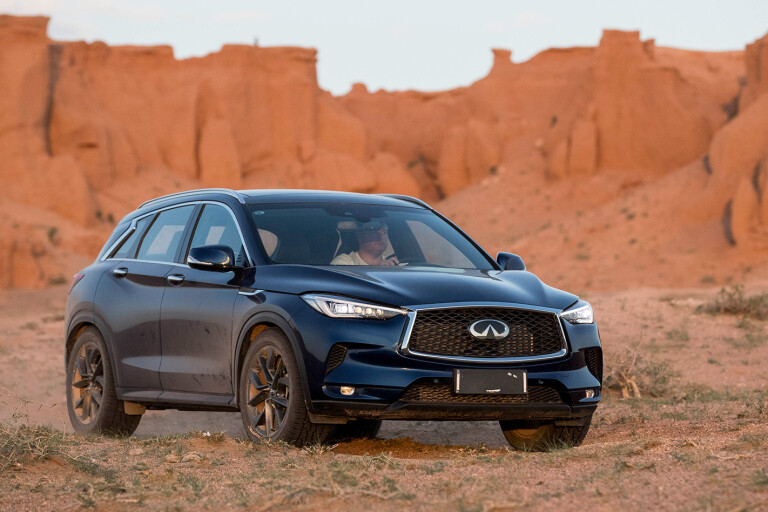
Not being able to see around the car they’re about to maniacally overtake doesn’t bother mad Mongolian motorists, however, because they all drive with their eyes closed. Oh, and the national speed limit is 80km/h, and even the main freeway has only two lanes, which the truck drivers use for playing chicken.
The trick to enjoying this mysterious, magical and mental place, then, is to get out of the capital, Ulan Bator (where we saw almost as many accidents as near-misses) and off the roads altogether.

Fortunately, Mongolia has plenty to offer outside of its capital, where more than half of its 3 million population live. A significant one third of the country is taken up by the Gobi Desert, where more than 1m of its people still live a nomadic lifestyle that Genghis Khan would recognise, farming 30 million herded goats, sheep, camels and hardy horses.
Mostly what’s out there, though, is space – searing sandy horizons, seas of grass and video-game-blue rolling hills that look like they’ve leapt off an old Windows screensaver. And then there are the dinosaurs, which are the real reason we’re here.

Infiniti, which recently unveiled something truly revolutionary inside its QX50 mid-size SUV – a variable-compression turbo engine – has developed a passion for hunting dinosaurs.
In June this year, the company joined with an exciting group of people called The Explorers Club to retrace the steps of a Mongolian expedition by a highly adventurous scientist called Roy Chapman Andrews (a man rumoured to be the inspiration for Indiana Jones), who discovered the first fossilised dinosaur eggs and was the first to find the bones of velociraptors (paleontologists now refer to them as ‘Hollywood dinosaurs’ chiefly because the real ones were feathered and the size of turkeys).
And because car companies don’t do things by halves, Infiniti also brought along experts in satellite and drone imaging who had previously worked with NASA on Mars exploration. By combining multispectral and thermal-imaging cameras, the team was able to help the scientists from Mongolia’s Institute of Paleontology and Geology to revolutionise the way fossils are hunted for.
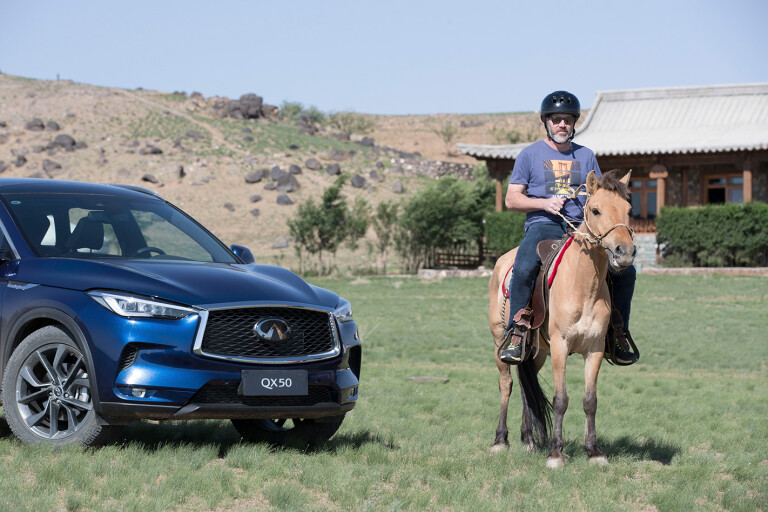
The result was an entirely new kind of three-dimensional map of vast swathes of the Gobi, which flagged unexplored sites suitable for fossil deposits.
The results were spectacular. In just 15 days, the expedition found the largest Tarbosaurus tooth ever collected (the Mongolian cousin of T-Rex and thus large and scary), 250 new fossil locations, potentially three entirely new species of dinosaur, a fully intact 70-million-year-old turtle and hundreds of bones from a meat-eating ancestor of the velociraptor.
Unbelievably, and rather excitingly, even if you’re not a nerd, we’ve been invited to join a preliminary dig at some of the sites the map had identified, but which had not yet been searched.
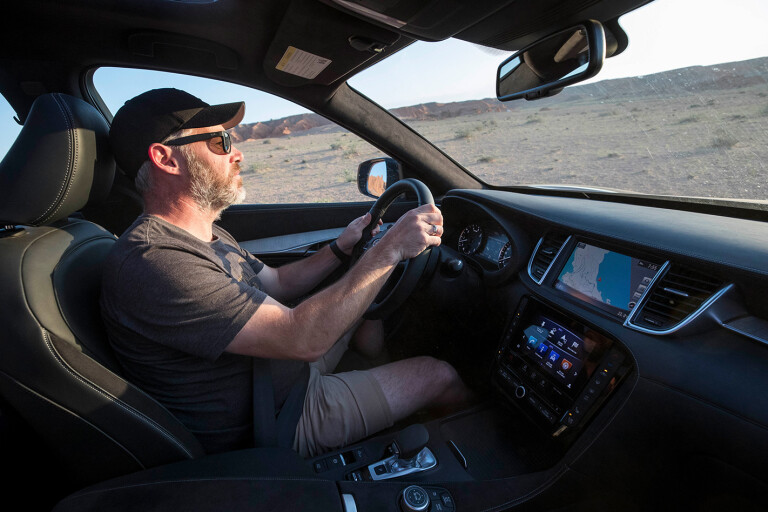
But first we had to get there, and as we soon discovered, going anywhere in Mongolia without ending up crazy enough to eat your own shoelaces is a challenge. The national airline, MIAT, which I think translates as ‘Walkingisquicker’ is another thing old Genghis would be familiar with, because very few planes ever took off in his day either.
Our first cancelled flight led us to a hired plane flown by a pilot who’d done his training on bumper cars. After a landing that would win Funniest Home Videos we were delighted to climb into the new Infiniti QX50 for the drive to the fabulous Three Camel Lodge. Here we stayed in traditional Mongolian ‘gers’, which are like yurts but warmer (this far-off country has the most extreme weather variations on Earth, from -40°C in winter to 40°C in summer).
Inside, they are a crafty construction of timber lattices and goat-felt-packed walls, all of which can be packed up and carried away in under half an hour.

The interior of the QX50, with its quality Bose speakers, timber-like finishes and generally classy feel, is a lot more modern than Mongolia, and is a big step forward for Infiniti. The perception of being in a blinged-up Nissan used to be hard to escape, but this is much better, and perhaps even more premium than a Lexus.
The look of the car from outside is also a significant improvement from some of Infiniti’s earlier Bullwinkle the Moose designs, although it’s still an outlier of personal taste around the snout.
Much was made of the fact that the cabin also features Bose noise-cancelling technology, but we were always going to be hard-pressed to notice it on the mix of rugged terrain and ‘hey, where did the road go’ tracks we’d spend our first day getting lost on.
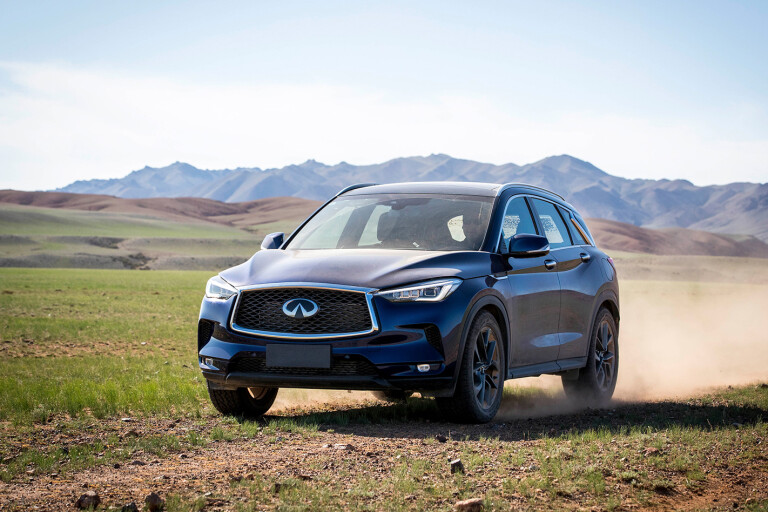
My co-driver, Toby Hagon, was raving about how amazing it is that the locals don’t get lost, even though they don’t use maps or GPS, just before we were told our guide had taken us the wrong way.
Still, the four hours we spent trying to find our destination gave us plenty of time to evaluate the car, and try out this clever new engine.
The 2.0-litre VC-Turbo succeeds where many car companies have failed, by creating an engine – now the subject of more than 300 patents – that can switch between high-compression ratios and low ones, constantly and seamlessly.
Infiniti uses a multi-link system that is continuously raising or lowering the pistons’ reach – depending on your throttle demands – to provide either the best possible fuel efficiency (a high compression ratio) or the most power and torque (low compression, with help from a very enthusiastic turbocharger).
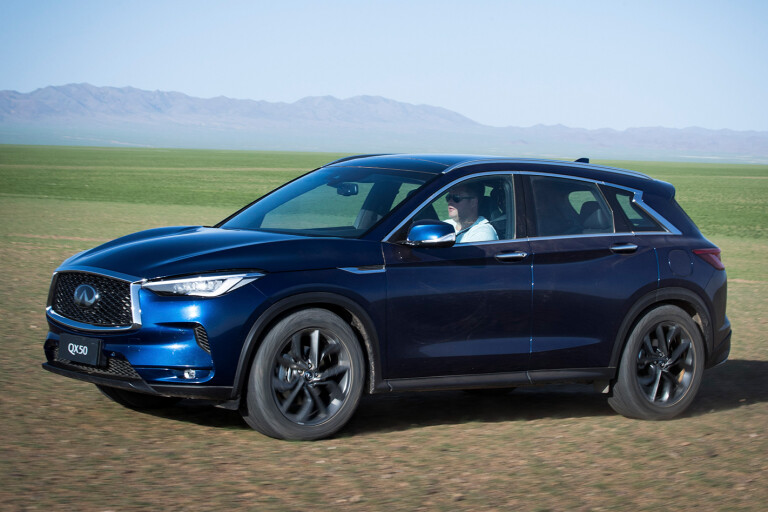
Infiniti claims the VC-Turbo can produce the performance of a V6 combined with the fuel economy of a four-cylinder diesel. Its official numbers are an impressive 200kW and 380Nm with a claimed fuel-economy figure of 9.0 litres per 100km.
Futurists whisper that this could be the engine that saves internal combustion, and kills off small diesel powertrains. Curiously, however, Infiniti – which has exclusive use of the tech until Nissan and Mercedes-Benz take it, which won’t be long – has declared that it aims to be ‘fully EV’ by 2021.
This, then, seems like a very important engine to be testing on roads where any kind of high-speed driving would kill you, or at least your car. Still, I can report that this new VC-Turbo does have the mid-range torque you’d expect from a larger-capacity unit. Poke it from anywhere around 3000rpm and you get a surge of acceleration that’s undoubtedly impressive.
Infiniti claims a 6.7 second time for the 0-100km/h, but it feels like it has the potential to be even quicker, because sadly the CVT spends at least the first second and a half moaning about life and basically choking all that power from getting to the ground.

Turbo lag does not seem to be the problem, as you can see the gauge spinning up to 1 bar very quickly indeed, so I blame the CVT. I’ve never liked these transmissions, which remind me of Marvin the Paranoid Android – undeniably clever but always moaning and slow moving.
There were some squeaks and groans from the chassis as well, which Infiniti explained with the all-purpose ‘these are pre-production cars’ answer, but to be fair the conditions were harsh, and the QX50 provided a good balance of ride comfort and involvement, overall. And did damn well to survive some of its punishment.
Unfortunately the drive-by-wire steering feels vague and distant from the front wheels, at least on dirt.
Cornering wise, the chassis certainly feels stiff enough to sit nice and flat. Overall, this is a far more complete and desirable SUV from Infiniti, and if it can get near its claimed fuel figure (we saw closer to 15 litres per 100km, understandably) its engine will be a real selling point of difference.
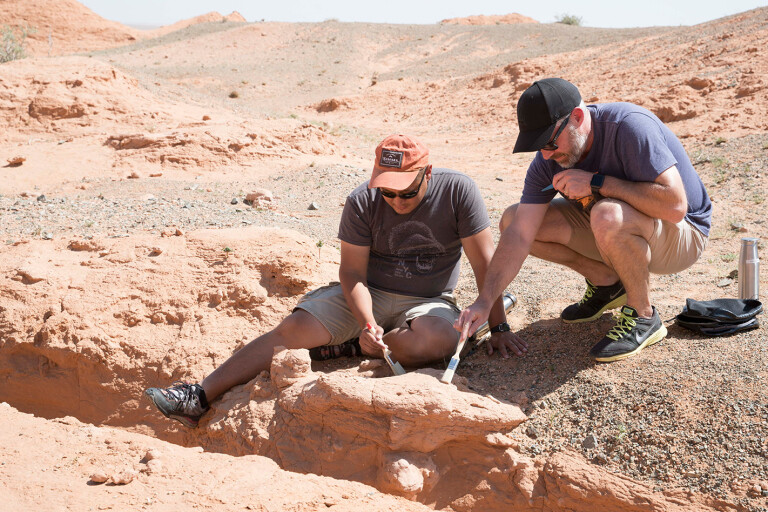
When we finally got to the site where we would do our dinosaur hunting, a place seemingly named by an Ocker Aussie – the Flaming Cliffs – I wasn’t sure what to expect, but I was wise enough to suspect that I’d be crap at it.
Professor Zorigt Badamkhatanhad, or Badmaa for short, had earlier shown us around his HQ in Ulan Bator, and never have I seen such a humble, dilapidated building hiding such wonders. In one corner sits a nest of actual dinosaur eggs, which immediately prompts the Jurassic Park questions (yes, he likes the movies, indeed his uni lecturer, Jack Horner, was a consultant on all of them, and no, the DNA from mosquitoes thing has no chance of working, ever) and on every surface seems to be something almost as mind boggling.
Badmaa insists, however, that the field is where the real excitement is, and it turns out he’s absolutely right. Equipped with my dinosaur-digging tool set, I spent the first half hour annoying the professor by excitedly calling him over to see what I’d found. It was a rock. Every single time. They sure do look like bones.
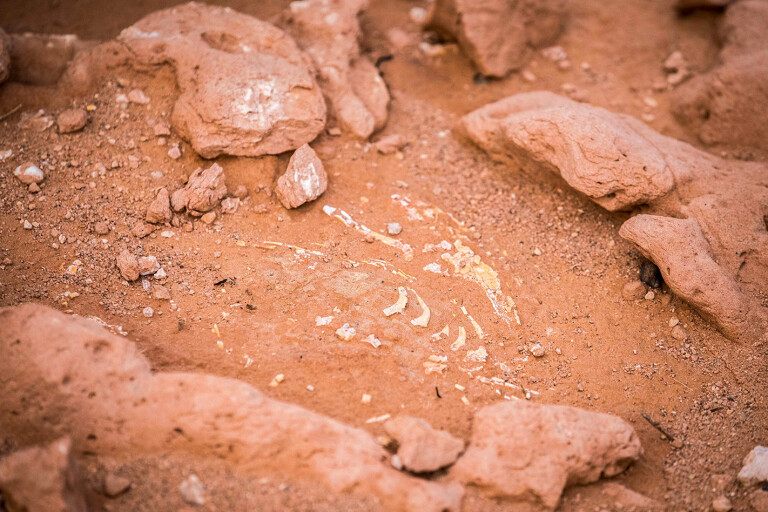
Until you see the real thing, that is. Badmaa found it, of course, and when he did his excitement was of a higher register than I think my seven-year-old daughter could manage.
“Oh my gosh! Look at this! It’s incredible! I’m so excited, look, look,” the tiny Mongolian professor tittered. Getting up close to what he was looking at, I could clearly see bones – ribs poking from the ground, a shoulder, a spine – washed clean by some rare rain the previous day, and thus never seen before by human eyes. Then I paused to think that, 80m years ago when this animal lay down to die, there were no human eyes.
The professor declares we’re looking at what could be a 98 percent complete example of a protoceratops. This takes a while to sink in, so I crouched down next to him and took my brush to something slightly white, just to the left of where Badmaa was gesticulating widely, and gently enquired whether it might be something. After some more whooping he told me I’d found something “very exciting”, a hip-shaped piece of the puzzle forming beneath us. And that I should stop touching it.
Fossils this old are incredibly fragile, so a recovery team will have to come out and dig up all the dirt for a good square metre around the bones, taking the lot out in a plaster ‘jacket’, back to that humble lab where it will be examined by excited scientists.
Badmaa, of course, would prefer to do it right now. “The waiting is hard, I just want to see it, but that’s why scientists are the worst diggers; we get too excited,” he explains, with an apologetic shrug.
“There are some very famous bone destroyers among paleontologists. I must admit, I’ve done it before myself. So we’ll wait, but look, you can see where the skull will be. And the teeth.”
Then he’s off again, this incredibly energetic PhD professor, who’s part biologist, part forensic scientist and all dino-mad.
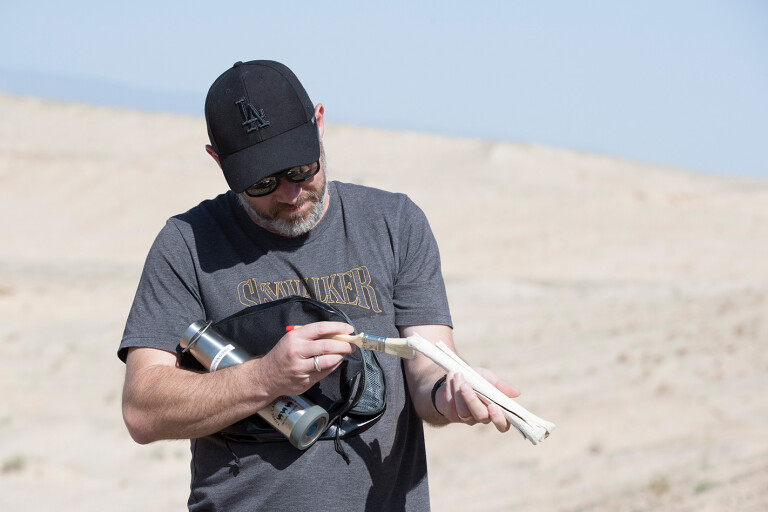
Not long after, I make another, smaller find, and hold in the palm of my hand a red rock, smaller than a tennis ball, which contains what are clearly several small dinosaur bones, compacted and trapped by millions of years of shifting sediments.
I’m completely alone with it, standing in the kind of silence you can only not hear in a desert as flat, vast and empty as the Gobi. And I am utterly humbled, shrunken by the scale of history and how tiny my place in it is.
It is, quite simply a moment I will never forget. A nerdgasm, if you will, and I can almost feel the six-year-old boy inside me hopping up and down with excitement.
Frankly, it was even worth enduring the madness of Mongolia for.

COMMENTS